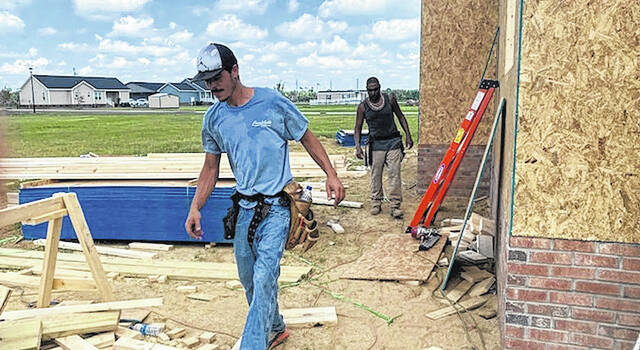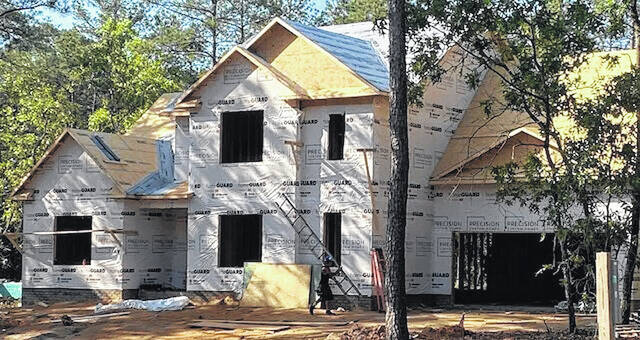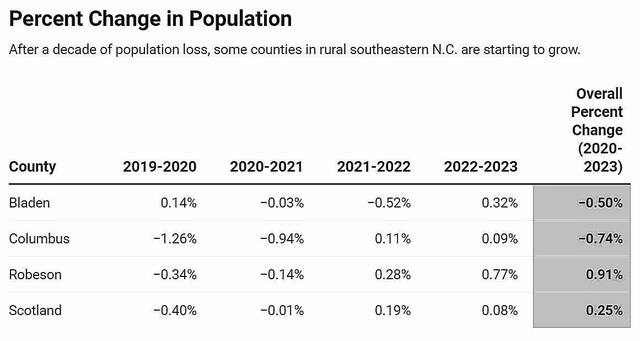
A construction crew works on a home in the Lumbee tribe’s Dreamcatcher community in Raynham on Aug. 4.
Sarah Nagem | BBI
Report: Population
increasing slowly
Robeson and Scotland counties grew between 2020 and 2023, mirroring population increases across much of rural North Carolina during the COVID-19 pandemic.
Robeson County grew by 0.91% during the three-year span, accounting for an increase of 1,056 people, according to a new report from the North Carolina Rural Center. Neighboring Scotland County grew by 0.25%, an increase of 86 people.
While any growth is welcome news in the economically distressed counties in southeastern North Carolina, population increases lagged behind the average for the state’s 78 rural counties. From 2020 to 2023, rural North Carolina grew 2.7%, adding almost as many people in three years as in the previous decade.
In Robeson County, which lost more residents than any other in the state between 2010 and 2020, County Commissioner John Cummings attributed the growth to “overflow from Fort Liberty.”
“We’re at the crossroads of the state,” he said, “and it’s ideal for industrial growth.”
The population in rural America dropped slightly between 2010 and 2020, the first decline in 50 years, according to the report. But rural North Carolina grew by 2.9%, adding more than 106,600 people.
The report attributes much of the rural growth to increased net migration that began in the late 2010s and increased during the pandemic, when schools switched to remote learning and many companies allowed employees to work from home.
“COVID-19 had some undeniable effects on population change,” the report said. “North Carolina appeared to already be on a path of rural growth, COVID-19 just pushed it along at a faster rate.”
Urban and suburban counties have seen the most growth, however, growing by about 4% from 2020 to 2023. And it’s important to note that rural growth has not been spread evenly across the state.
Much of southeastern North Carolina saw population losses during the last decade, including Robeson, Scotland, Columbus and Bladen counties. (Bladen saw a 16% drop during the decade, the biggest among the four Border Belt counties.)
Uneven growth continued over the past few years. “While growth was expansive, the counties with the largest population increases appear to be those rural and suburban counties around major urban centers,” the report says.
Brunswick County, which neighbors Wilmington, saw the largest growth in the state between 2020 and 2023, growing by 18%.
But nearby Bladen and Columbus counties saw population decreases of 0.5% and 0.74%, respectively. They were among 18 counties, all rural, that lost population during that time. Most of the other counties were in the northeastern region of the state.
Columbus County is on the cusp of growth, though. More than 10,000 homes are slated to be built in the southern part of the county in the coming years.
Bill Holmes, communications director for the N.C. Rural Center, said rural growth is a balancing act. Some rural residents are resistant to change and don’t want their communities to grow dramatically. But they also want to ensure there are enough people and local amenities to keep their communities vibrant.
“You’re either growing or you’re dying,” Holmes said. “So it’s great to see so many of these communities growing after a long period where they were losing population.”
Mark Ward, economic development director for Scotland County, said the loss of factories over the decades has hurt the area.
“We saw two manufacturing facilities close and the people left in droves,” Ward said. “So even that slow trickle in is something we welcome.”
Ward said Scotland County is well positioned to slowly grow because neighboring Hoke and Moore counties have water issues that could stagnate growth. Meanwhile, Scotland has expanded its water system, receiving nearly $30 million in this year’s state budget for upgrades.
Scotland County Manager April Snead said the focus has always been on ensuring enough resources for everyone, regardless of population size.
“With population growth comes families, schools, entertainment and health care needs,” she said. “It’s a range of needs for people to be healthy and enjoy their quality of life.”
Ward said the key is to attract industries while “making sure we don’t lose that rural charm.”
“This growth, however small, didn’t happen overnight,” he said. “It may be one percent growth this year, but in six or seven years we might see five or six percent. We know this is a marathon and we are going to do what we can to make small steps yield better results in the years to come.”
Campbell Soup Company recently announced it would invest $150 million at its Robeson County facility, creating about 100 jobs in Maxton. Cummings said he hopes the jobs will attract young families.
“I would prefer my daughters to be living here than anywhere else,” Cummings said. “But the only way to do that is if Robeson County continues to grow.”
While population growth is a good sign for rural North Carolina, the report cautioned that the trends might not last. Data suggests that national population shifts are returning to pre-pandemic realities.
“We don’t know if this is short-term growth,” Holmes said, “or if this is going to kick off a long-term trend.”











